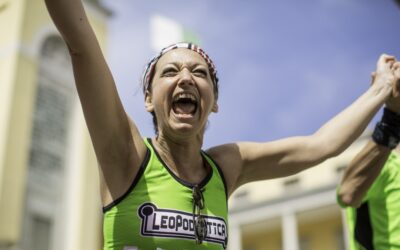The history of women’s six day ultra races has been overshadowed by the focus on the men’s record. The impetus for writing this series of posts came from interviewing Eleanor Robinson and Lorna Richey Michael (interview to be published soon) about their involvement in New York Road Runners Six Day Track Race in 1984. When researching Richey Michael’s story, I realised that 1984 was a stellar year in the history of the women’s event. It was the year when the record changed hands five times and women drove the distance up by 91 miles in just 8 months. There hasn’t been a year like it before or since.
This post looks at the origins of women’s six day races in Victorian-era pedestrianism, the revival of the format in 1980, and the first woman to subsequently compete in a six day race – Marcy Schwam.
In future posts, I will look at the women who extended the “modern era” six day record after Marcy Schwam in 1981. Nottingham, UK, briefly became the focus of women’s six day racing as the record was set there twice. In 1984, five women raised the record, and one of them exceeded 500 miles/800km for the first time. I’ll look at how the record progressed after 1984 and at six day racing today, including the forthcoming women-only race announced by athletic brand, Lululemon1.
The origins of women’s six day races – pedestrianism
Pedestrianism was a popular sport for most of the nineteenth century in both the United States and Great Britain. Walkers, both men and women, competed in solo challenges or in races for cash prizes. Such events often attracted large crowds with much gambling taking place.
An American, Edward Payson Weston, popularised the six day format. In 1874, he attempted to walk 500 miles in 6 days, succeeding at his fourth attempt. A craze for six day races soon developed, as Derek Martin has described:
In the mid-1870s the world of long-distance pedestrianism was transformed under the influence of the American Edward Payson Weston. After a career in the United States, including the first ever walk of 500 miles in six days, he arrived in Britain in 1876, where his ability combined with a flair for publicity roused great public interest and no little combative spirit amongst British pedestrians….Contests proliferated on both sides of the Atlantic. They were generally on the ‘go-as-you-please’ principle (walk or run, the competitor with the furthest distance at the end wins). They ranged from what became the ‘classic’ race, six days and nights continuous, down to local contests of fourteen, twelve or six hours a day. Their popularity was such that by 1876 Athletic News was identifying ‘a pedestrian revival’ and the following year Bell’s Life proclaimed ‘a long-distance walking craze’.2
Women’s six day races in the 1870s
Women took part in their own six day races in both the US and Great Britain. Davy Crockett identifies 1876 as the year of the first women’s six day race. Held in Chicago, the event attracted several thousand spectators. In 1879, 17 women’s six day races took place in the United States. Whilst the men’s nineteenth century record set by George Littlewood in 1888 was known about when the six day revival began, there was less clarity about the women’s record. At times, it has been stated to be 393 miles, set by Amy Howard of the United States in 1879. However, Andy Milroy noted in 2008, that Howard had covered a longer distance of 410 miles 251 yards at a “World Championship” race in San Francisco in May 18803.
The huge surge in interest in pedestrian challenges waned after the 1880s and the six day format died out. It was to be ninety years before it would be revived.
The revival of the six day race in 1980
Chinese-American ultrarunner Don Choi and his friend and fellow ultrarunner Ed Dodd are credited with reviving interest in the six day format. Dodd became interested in the history of the Victorian races and co-authored a book with Tom Osler, “Ultramarathoning: The Next Challenge”, published in 19794.
In 1980, Choi and Dodd organised two six day races in the United States. The Spirit of ’80 Six Day Track Race in July was organised by Choi and had four finishers. Dodd organised the Edward Payson Weston Six Day Track Race in August which had six finishers. The latter race was named after the famous American pedestrian racer of the Victorian era. Don Choi won both races with 401 miles and 425 miles respectively. No women competed in these races. (Read more about Don Choi and Ed Dodd on the Ultrarunning History website.)
Marcy Schwam – first woman in the new era of the six day race
Marcy Schwam in the Edward Payson Weston Six Day Race by Joe Greene, Ultrarunning magazine September 1981

In 1981, Marcy Schwam, aged 28 (born 1953), competed in the Second Edward Payson Weston Six Day Race. As the first woman to compete in a six day race in this new era of ultrarunning, Schwam set the mark for women. She was the only woman in the race. This was not surprising as very few female runners were focusing on ultrarunning at the time. Women had only been admitted to marathons and other road races in the 1970s. The marathon was the main focus for elite athletes. This is evidenced by the fact that the world best was set 14 times in the 1970s5. It took time for depth to build up in the women’s field in road running and for women to transition from marathons to ultrarunning.
An article in Ultrarunning magazine in October 1981 describes Schwam as a construction worker and “a sports nut since grade school and was a collegiate tennis standout until specializing in ultrarunning.” She ran her first marathon, the Boston Marathon, in 1974. In an interview in Ultrarunning in 1982 she explained how she came to run her first ultra in 19776.
I wasn’t bored, but I wasn’t exhausted at the end of marathons. Maybe I wasn’t running them hard. Anyway, I was having no problem with endurance, so in December 1977, I ran my first 50km. I found I enjoyed the training needed for ultras and, after a 40 miler in Forest Park in New York City a few months later, I realized that I wanted to concentrate on ultras.
Marcy Schwam at the Edward Payson Weston Six Day Race

Race results, Ultrarunning, July/August 1981
The Second Edward Payson Weston Six-Day ‘Go As You Please’ Track Race was held on a quarter mile cinder track in Cooper River Park, Pennsauken, New Jersey, from 21st to 27th June 1981. Entrants needed to have completed a race of 100 miles or longer to compete. Schwam held the 100 mile world record (15 hours 44 minutes 27 seconds), set as a split time in the first Sri Chinmoy 24 Hour Race in November 1980. This surpassed both the track and road records for the distance.
In his account of the race in Ultrarunning magazine, Dan Brennan described Marcy Schwam:
The lone woman entrant was a terror from the start, leading the entire field for the first 70 miles after starting with a 3:27 first marathon! Religiously resting from midnight to 4am and from noon to 4pm every day, she was relentless in her running at all other times, throwing in brief brisk walks and occasional 5 minutes breaks.
Nick Marshall, writing in the Road Runners Club newsletter, commented that “Schwam proved to be the best at sticking to a methodical plan.” Marshall, who camped out at the track for the whole week, was one of the few people there for entire race. He said that in the last hour there was “a crowd of several hundred spectators, cheering loudly for all the runners on the track”7.
Schwam ran 384 miles (617.988km), finishing second overall to Park Barner who ran 430 miles. Both Brannen and Marshall felt that Schwam could have run further had she not developed Achilles problems in the last two days. Schwam also held the 48 hour world record which she improved on in the Weston race, running 158 miles.
In conclusion
Read more about Marcy Schwam’s sporting career on the Ultrarunning History website. View a list of her ultra races on the DUV (Deutsche Ultramarathon Vereinigung) website.
In a short video in Saucony’s series “The Good Runner” from 2020, Schwam says “Women weren’t doing long distance events then. There was a lot of belief about why we shouldn’t. I was very determined to prove that wrong.”
Schwam’s performance was recognised as a world record by Ultrarunning magazine. This is also recorded in her 2005 entry in the American Ultrarunning Hall of Fame. The lack of clarity over the women’s nineteenth century best performance may suggest that both contemporary and later collators of statistics have given more attention to men’s performances than to women’s.
In this series of posts, I will focus on the modern record starting with Marcy Schwam, rather than attempting to draw a line back to the late nineteenth century.
In my next post, I will describe how Nottingham briefly became the focus of women’s six day racing as the world record was set there in two consecutive years.
Notes
Summary of the world record progression
- In May 2023, athletic brand Lululemon announced a women-only six day race which will be held in March 2024. (Press release, 23rd May 2023)
- Martin, D. A Short History of the Barclay Match: Long-Distance Pedestrianism in the Nineteenth Century, In Piercey, N. and Oldfield, S.J. (ed), “Sporting Cultures: Global Perspectives” (Manchester: MMU Sport and Leisure History, 2019), 149-165. Available on the Playing Pasts website.
- For example, Women’s International Six-Day (1879) on the Ultrarunning History website records Amy Howard running 392 miles. Rosalind Paul in her account of the Second Charles Rowell Six-Day in 1982 states that Andy Milroy told her “the old professional record of Victorian times” was 393 miles (Road Runners Club Newsletter, January 1983). Also see “The History of the 6 Day Race”, Andy Milroy, 2008, Planet Ultramarathon website.
- “Ultramarathoning: The Next Challenge”, Tom Osler and Ed Dodd, World Publications, January 1, 1979. Osler and Dodd had previously published an article “Six-Day Pedestrian Races” in the “Annals of the New York Academy of Sciences” 301, no. 1 (1977).
- “Progression of World Athletics Records”, World Athletics, 2020.
- “Watson vs Schwam: A Look Back”, Nick Marshall, Ultrarunning October 1981, and “Marcy Schwam: ‘I don’t fear the races any more’”, Stan Wagon, Ultrarunning October 1982
- “Runners from both coasts in Weston Memorial 6 Day”, Dan Brannen, Ultrarunning September 1981, and “The Second Weston Six-Day ‘Go As You Please’ Track Race”, Nick Marshall, Road Runners Club Newsletter, January 1982.




Great article
I was at the 1981 race
It was awesome
I was 23 years old
Ive got some good pictures if you need them of the 1981 race
I also did the Nottingham 6 day race in 1981
Thank you Chet the Jet! I’m impressed that you could do two 6 day races in a year and 23 is quite a young age for multi-day racers. It would be great to have some pictures as they are very hard to come by. I’ll email you. Katie